MusicRadar Verdict
Comparisons aside, TEO-5 does deliver enough of its own character to make it one of the best mid-priced polys around.
Pros
- +
Lovely hands-on synth that really lets you get dynamic with its sound.
- +
We like the oscillator and filter setups in particular.
- +
Hands-on effects let you shape sounds very quickly and dramatically.
Cons
- -
Five voices is limiting for those big Oberheim pads.
- -
Could have been a little lighter for gigging.
MusicRadar's got your back
Oberheim TEO-5: What is it?
The problem with writing about Oberheim’s new TEO-5 is trying to hold back on the inevitable comparisons with other synths it is – or is not – based on. It has the sound of many a classic Oberheim synth packed into its solid and compact body so could be seen as a cut-down OB-X8, although one that is not so cut down in features as it is in physical size and polyphony. (TEO-5 has five notes compared to OB-X8’s eight.)
There again, we could see it as Oberheim’s ‘take’ on the Sequential Take 5, a compact version of the classic Prophet-5. It is the same weight as Take 5 (down to the gram), has exactly the same dimensions, and shares lots of similar features.
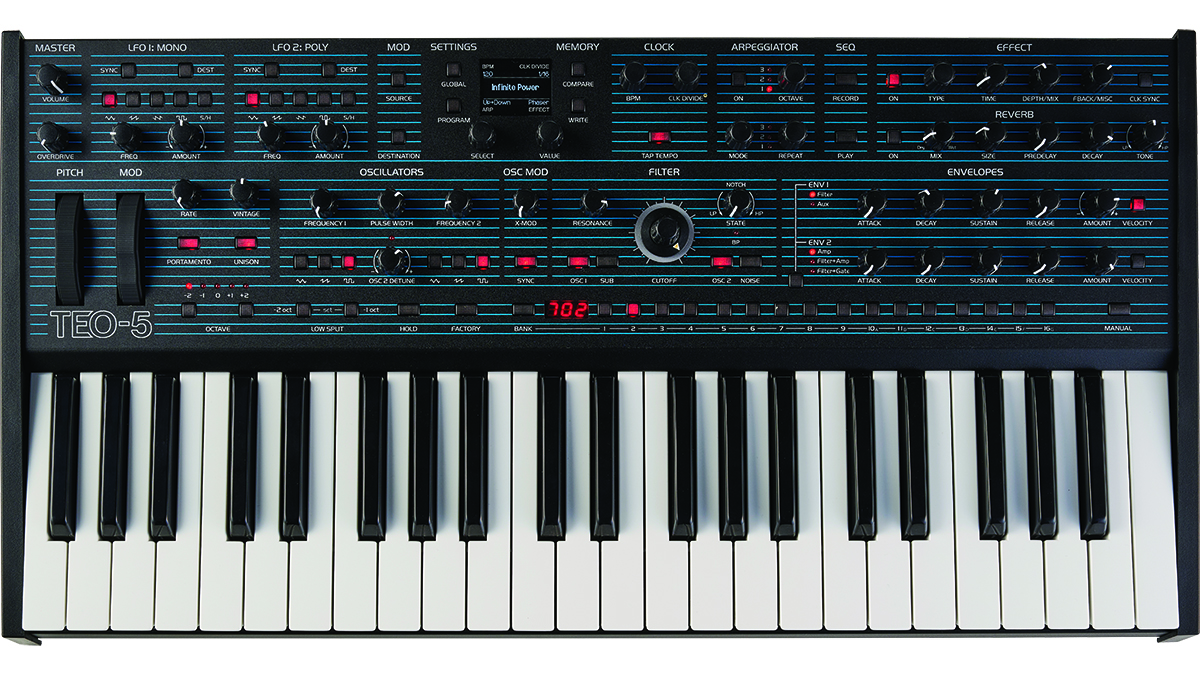
But rather than just fill out the rest of this review with how these various synths stack up against one another, it’s probably easier to treat it as a new synth in its own right, or we’ll end up going comparison crazy. The bottom line, though, is that TEO-5 is a lot of synth for the cash, as we’ll reveal…
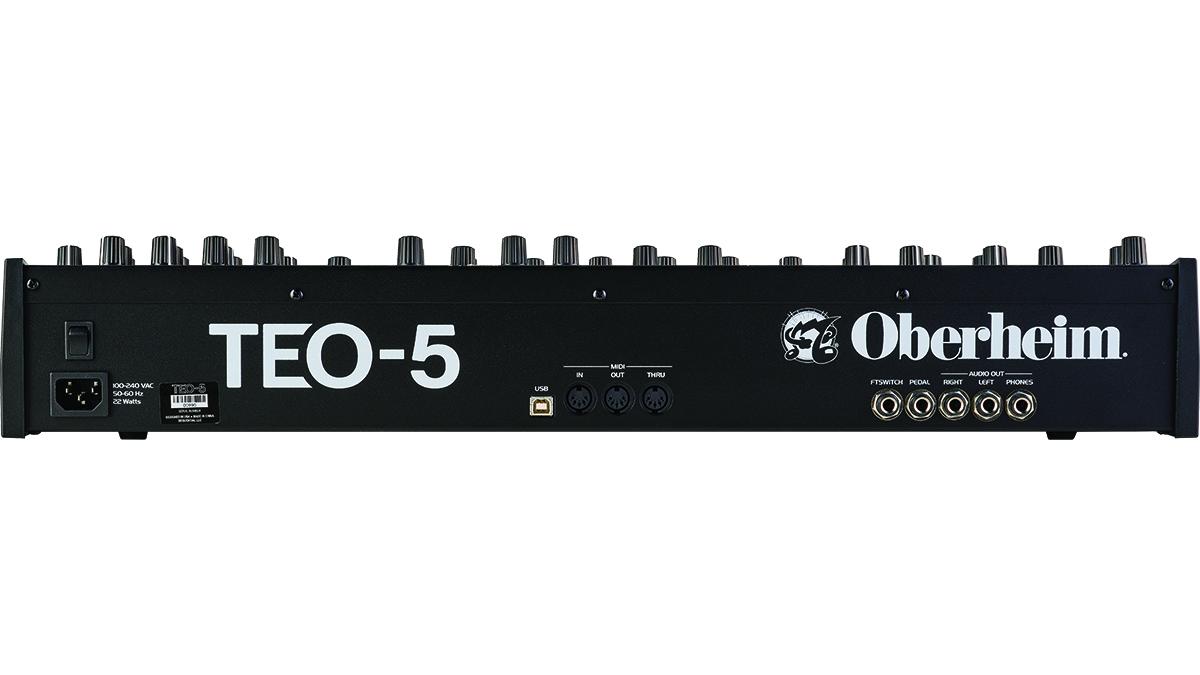
Oberheim TEO-5: Performance and verdict
Having spent a while with the synth now, we can pretty much sum up that it is one of those great synths that lets you do a lot of stuff with hands-on ease, but lets you go deeper if you wish. There’s a lot of simple envelope and LFO modulation to hand, loads of other controls to change oscillator shapes, sync and modulation options, plus a lovely state variable filter. So there is loads to swoosh up and gnarl your sound in an instant, but a lot more options are there too, and just a few button pushes away.
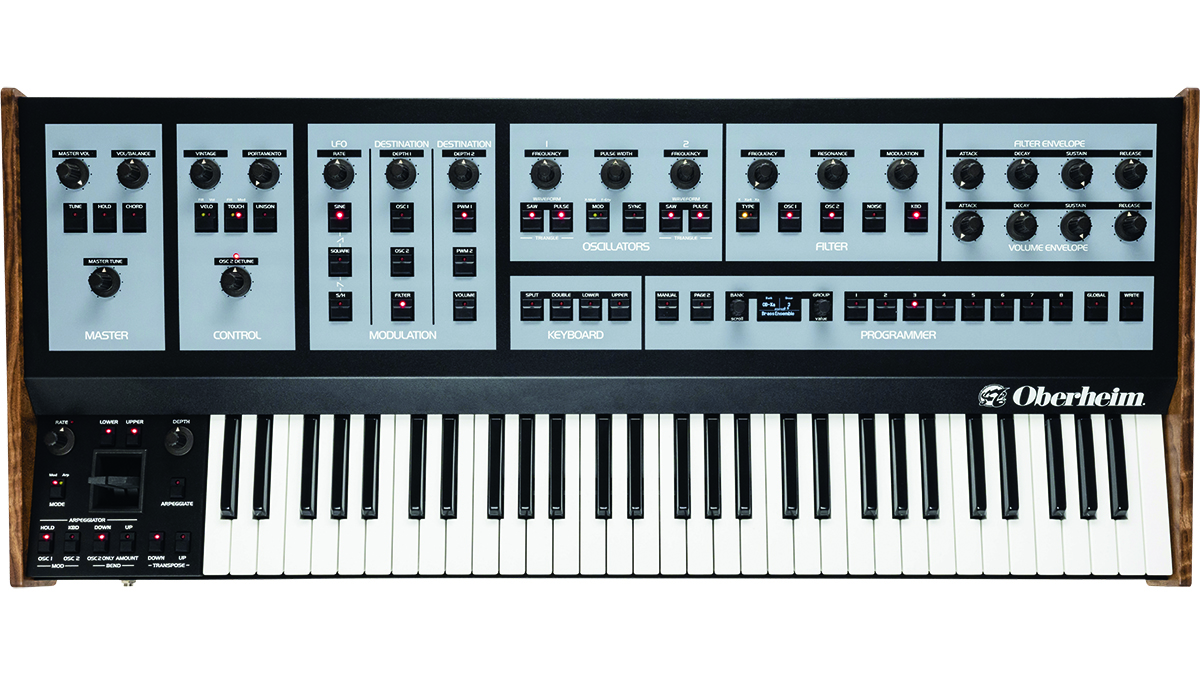
• Oberheim OB-X8
The synth that TEO-5 is trying (and succeeding in many ways) to emulate. That mouth-watering price gets you eight voices of polyphony and a ‘best of’ the OB range. (But you could buy two TEOs and have ten notes!)
• Sequential Take-5
You can’t ignore this, as it’s literally the same shape and size, but it does have a different flavour with a classic P-5 filter and a different oscillator setup.
• Behringer UB-Xa
The Big B’s Oberheim take has 16 voices and is multi-timbral, so is another option not to be sniffed at, especially at that three-figure price (which we’ve seen even lower).
And we do mean a lot. The Program section is just one where you find all the parameters that don’t have individual hands-on controls on TEO-5’s front panel – the kind of stuff you don’t need to access all the time. There’s a lot to discover here, although some might argue that some of the oscillator parameters, in particular, deserved their own rotaries, and a mixer section with faders would have been good too.
On this latter point, there are simple buttons for switching oscillators, noise, and the sub on and off, but it’s also possible to adjust levels via a long button press, and use the neat OLED screen to tweak them up or down. When you’re designing a synth of this size though, we would guess that something does have to give and these physical dial omissions are hardly deal breakers.
At the core of the synth, the sound generators are two VCOs, a sub, and a noise generator. The VCOs have any combination of three waveforms to hand (or just use one with simple button presses). The Pulse Width knob actually affects both oscillators at the same time, but you can focus on a certain oscillator by holding its button down and changing its pulse width that way. An actual pulse width modulation option is not available as a physical dial but very easy to set up via TEO-5’s excellent modulation setup, which we discuss below.
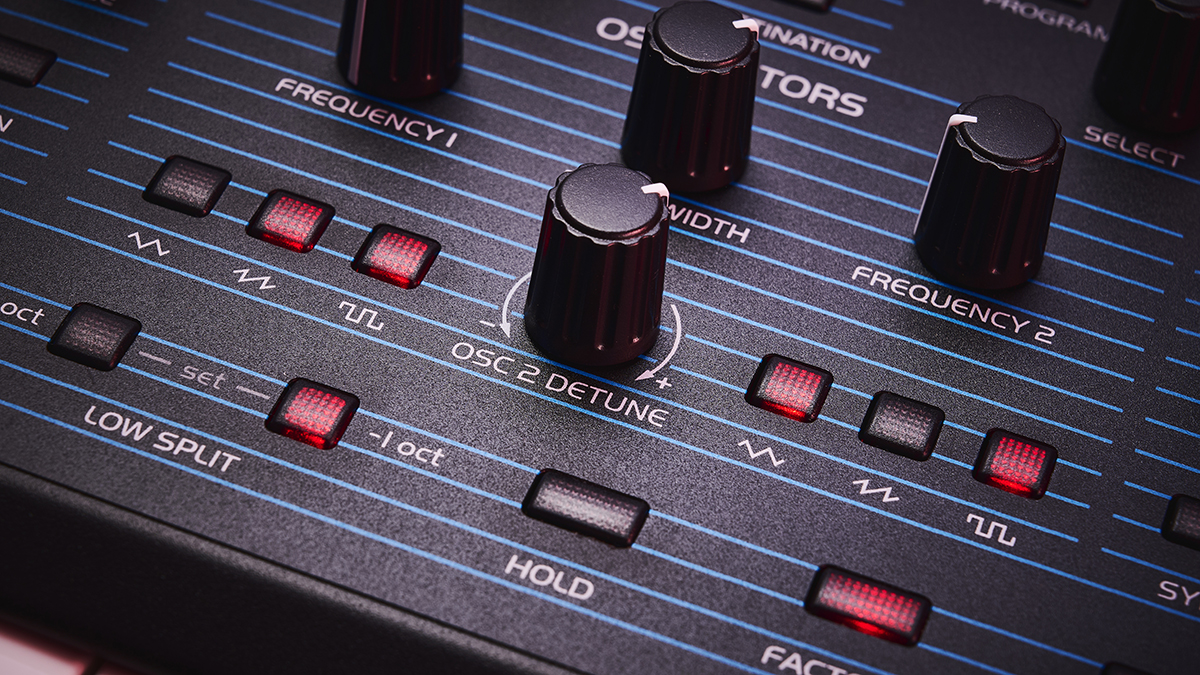
It gets very interesting with the Osc Mod section which is next to the oscillator block. Here you get X-Mod and Sync dials, the former being a beefed-up way to make Osc 2 modulate the frequency of Osc 1 with its triangle waveform. X-Mod sets the level of the modulation but uses ‘through zero FM’ which differs from standard FM as the frequency of the carrier can go ‘through zero’ (ie negative) and gives richer, more varied results than the sometimes clangy ‘standard’ FM. That said, we found a little experimentation with it certainly resulted in unusual but useable results, especially by combining the Osc 1 waveshapes being modulated, and altering their frequencies. Do take care here though as it’s easy to go completely off-road sonically.
The TEO-5 filter is a 12dB 2-pole SEM which doesn’t self-oscillate, but is state variable so can move between high band and low-pass for some real sonic character. This is one of the standout hands-on features to experiment with on TEO-5, and already you can see we’ve used the words ‘hands-on’ way too many times as there are so many dials to get your sound moving. And that’s even before we hit the effects section.
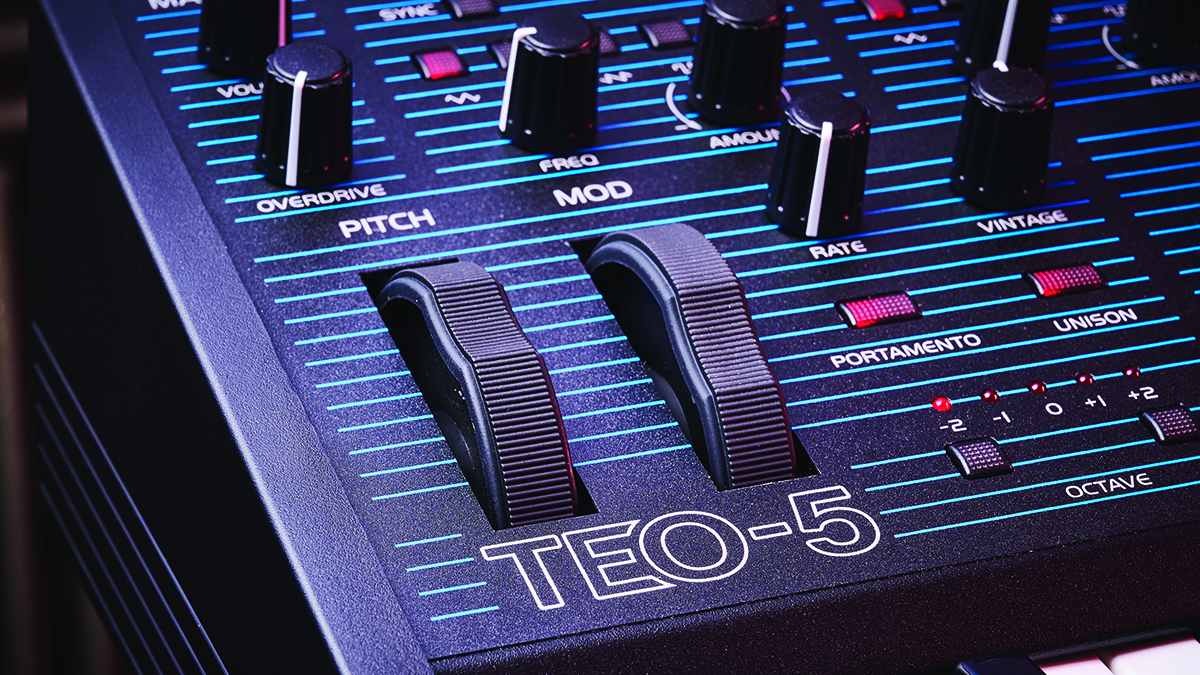
Effects and sounds
TEO’s dual effects sections and dedicated Overdrive control all seem to be lifted from Take-5 with the two effects blocks, at the top right, and the (great and powerful) Overdrive effect on the left. You get a dedicated reverb and a multi-effects block to choose from delays, chorus, distortion, and more. These are big and bold effects that might be too much for some, and their digital nature might have analogue purists running to the hills. We don’t buy that train of thought, however, and have always liked this blend of analogue signal path and digital effects that we first came across on the Prophet-6 and OB6 – two other great machines.
And so to the sounds that all these features add up to, and there’s a good spread of cheesy rock, luscious atmosphere, big beefy pads, and equally meaty bass among the 256 factory sounds (with a further 256 locations to save to). There are also genuine moments of wonder. One preset is called Pressure Pluck, an arpeggiated sound that we used for our filtering and X-Mod experiments and – pure chance we have to say – turned a decent arpeggiated bassline into one with beats that blended in. This is not a bi-timbral synth, so all of the beats and bass were coming from the one sound. Which, we’d hasten to add, we could now argue we programmed ourselves. Thanks very much. Many of these moving sounds take advantage of all of those controls to tweak and you most certainly will.
If we haven’t made it clear yet: this is a programmer’s synth and you’ll be hitting the ‘Write’ button a lot!
It’s not all great presets-wise though, which we have to mention just for balance. Oberheim sold a lot of keyboards to proper rock players and while that sound doesn’t float our boat, one or two (too many) sounds are dedicated to those and the music they made. Can you resist playing the intro to Jump? We certainly can. But at least Oberheim recognises its legacy and doesn’t take itself too seriously with names like Rock Cliché. And besides, just in case we haven’t made it totally clear yet: this is a programmer’s synth and you will be hitting the ‘Write’ button a lot!
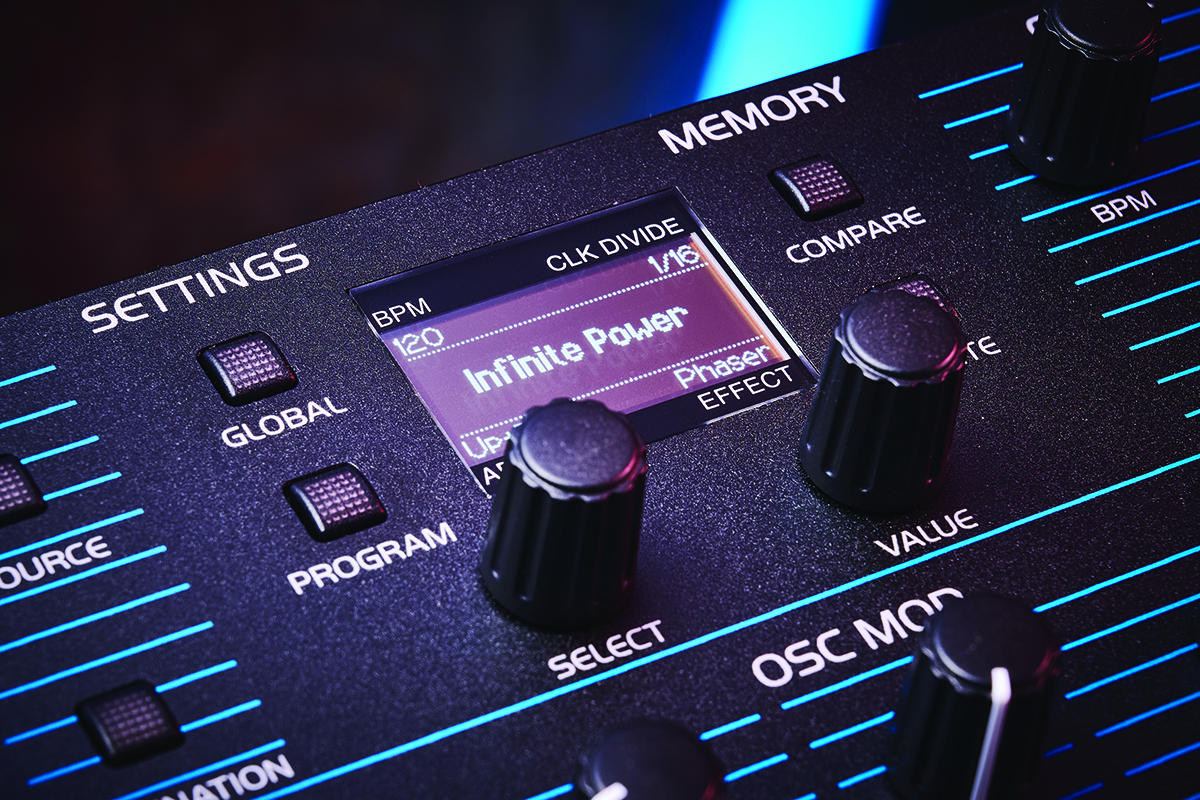
More modulation fun
One of TEO-5’s highlights is its modulation power, delivered in a very slick, tactile route with two LFOs and two envelopes. However, you also get a more in-depth way that opens a lot more modulation doors by way of a 19-slot modulation matrix, with 19 different sources and 65 destinations.
The LFOs are single (per voice) or Global (applies to all five) so you can apply a more consistent modulation to chords or a more dynamic one as you play individual notes. It’s easy to apply LFOs to anything: just hold their Dest buttons down and choose a destination onscreen. Or, there’s a shortcut section where you hold the Source button down, move what you want as your source (LFOs, mod wheel etc), then hold the main Destination button and choose one. Simple stuff! You can also enter the matrix and assign what you like across multiple slots.

Conclusion
There is more packed into this synth than either its size or price suggests. On top of what we’ve covered, there’s a simple sequencer and arpeggiator (both decent and easy to use). There’s a Unison mode for delivering that huge, fat trance sound by effectively turning your synth into a mono, but firing all five voices at the one note, detuning them and getting all 1997 again.
And within Unison mode there’s a Chord Memory mode where you play a chord and TEO-5 stores the notes so you can then transpose that chord up and down the keyboard by playing a single key. Finally, there is the genuinely great Low Split keyboard option that lets you extend the keyboard downwards by a couple of octaves – not physically, obviously, you lose your existing octaves and they just play lower, but it’s great for players who want that wider range.
TEO-5 is a very clever performance and sound design synth created for a small footprint and low price. Some will feel limited by the polyphony and there are many other great synth options out there for similar money or even less. However there is enough personality here to set TEO-5 apart from all the synths we were trying to align it with at the top of this review, and we think you’ll be playing all of the easy modulation and SEM filter variations, and creating new sounds with reckless abandon with it in no time. Just don’t go using it to play Jump anywhere that we can hear you, please.
MusicRadar verdict: Comparisons aside, TEO-5 does deliver enough of its own character to make it one of the best mid-priced polys around.
Oberheim TEO-5: The web says
"Far from being a cut‑down version of one of its bigger siblings, the TEO‑5 is a brand new Oberheim synth with a personality of its own."
Sound On Sound
Oberheim TEO-5: Hands-on demos
Oberheim Official
sonicstate
loopop

Andertons Synths, Keys and Tech
Oberheim TEO-5: Specifications
- KEY FEATURES: 5-voice analogue polysynth; 44-note semi-weighted Fatar keyboard with velocity and aftertouch; two VCOs, a sub oscillator plus noise; SEM state variable filter; two LFOs; two DADSR envelopes; extensive modulation; 64-step polyphonic sequencer; multimode arpeggiator; two effects generators (dedicated reverb + multi-effects) plus overdrive.
- CONTACT: Oberheim
Andy has been writing about music production and technology for 30 years having started out on Music Technology magazine back in 1992. He has edited the magazines Future Music, Keyboard Review, MusicTech and Computer Music, which he helped launch back in 1998. He owns way too many synthesizers.
"There’s plenty for us guitarists to learn – and ‘less is more’ is the overriding lesson": how to play like George Harrison on The Beatles' Abbey Road
“They didn’t like Prince’s bikini underwear”: Prince’s support sets for the The Rolling Stones in 1981 are remembered as disastrous, but guitarist Dez Dickerson says that the the crowd reaction wasn’t as bad as people think
“We are so unencumbered and unbothered by these externally imposed rules or other people’s ideas for what music should be”: Blood Incantation on the making of Absolute Elsewhere and how “Data from Star Trek” saved the album – and the studio














